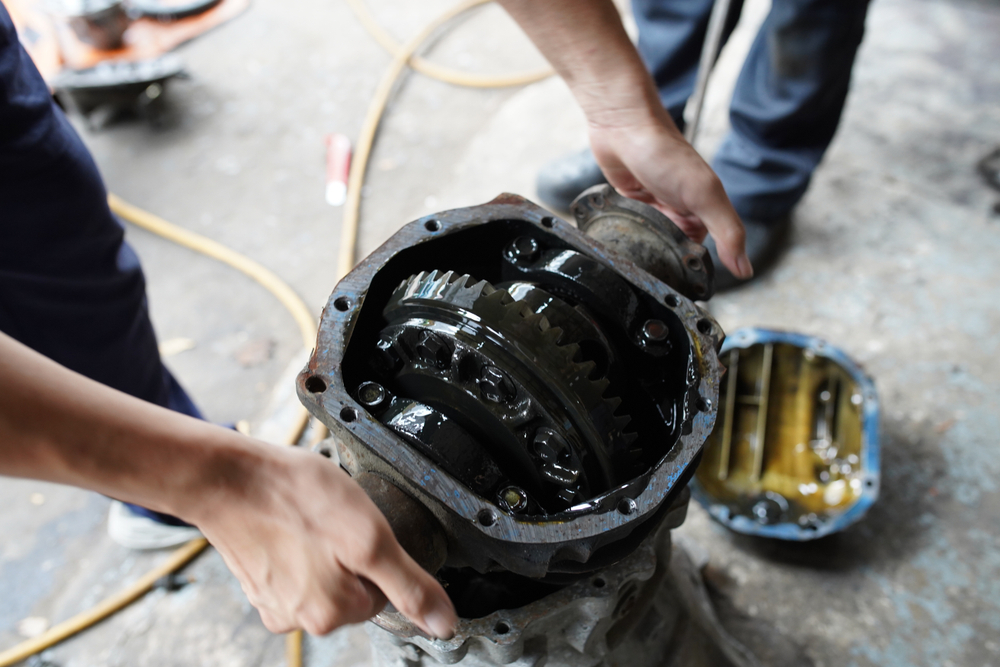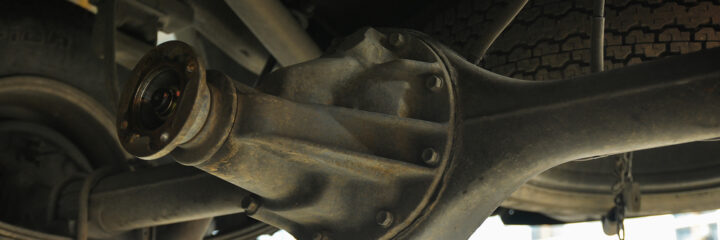A differential is a series of gears that allow your car to take corners better. Without it, you would notice horrible noises every time you turned your steering wheel, and you’d have to buy tires more often. Therefore, it’s important to keep the differential well-lubricated and happy.
If it’s been more than 30k miles since your last service, or you just want to know more about how differential fluids are changed, then this article is for you. We’ll talk about what differential fluid is, how to change it, and answer some questions from around the web.
What Is Differential Fluid?
For the average commuter car, differential fluid and transmission oil are identical. That’s because a standard front-wheel drive vehicle has a differential that is integrated into the transmission.
However, rear-wheel drive and all-wheel drive vehicles have a separate differential, or differentials, filled with a thick,heavy oil. This heavy oil is meant to last a long time, and it is usually some of the thickest fluid you can find in your car. It’s not uncommon to see 80 or 90 weight oils in a differential; compare that to the 30 weight in your engine like 5w-20.
Before You Start
There are just a handful of things you should know before you get ready to change the fluid.
When to Change Your Differential Fluid
Your car’s service manual will list the intervals between fluid changes. In general, the fluid should be changed every 30,000-50,000 miles, depending on how hard you drive. If you do a lot of demanding driving or driving in extreme temperatures, then the interval will be shorter. Conversely, if you do a lot of simple highway commuting, you can probably wait longer.
Differential Locations
Most differentials are located between the two rear wheels. They will have two output shafts, one for each drive wheel and one input shaft from the transmission. However, that isn’t always the case, so here are some notable exceptions.
Subarus
Subarus, except for the BRZ and SVX models, have two separate differentials. Each differential has its own fluid reservoir, and you will often service both at the same time. The only difference between them is that the front differential usually has a few plastic covers that need to be removed before you can get to the drain plugs.
Other AWD Vehicles
Non-Subaru, all-wheel-drive vehicles will often only have one serviceable differential in the rear instead of a front and rear. That’s because most AWD vehicles are front-wheel drive vehicles with an added transfer case and rear differential, meaning the front differential shares its fluid with the transmission like a standard FWD vehicle.
4x4s and Other Special Cases
On trucks and other large vehicles, there will be a differential for every pair of drive wheels. So a 4×4 truck will have a front and rear differential, and a 6×6 military vehicle will have at least one front and two rear differentials.
Some off-road-oriented 4x4s will have 3 differentials: one for the front wheels, one for the rear, and one between the front and the rear. By locking differentials together, you have complete control over which wheels receive power, which is an essential part of offroading.
Types of Differentials
In general, there are 3 main types of differential. You can find an expanded list of differentials and how they work here at Car and Driver’s website. We will simply touch on the basics so you can feel more confident when you service the one on your car.
Open Differentials
Open differentials are the simplest and oldest types. They allow one wheel to spin while the other remains stationary so that you don’t have to worry about different tire speeds when cornering.
Locking Differentials
Locking differentials are mostly found on trucks and off-road vehicles. The differential can be “locked,” and both output shafts will turn at the same speed to maximize traction.
Limited-Slip Differentials (LSDs)
Limited-slip differentials can allow both tires to turn at the same speed while accelerating and then allow both tires to spin at independent speeds while cornering. This is good for race cars that need to deliver maximum power to the wheels, but still navigate corners at high speed. They are also good for light off-road vehicles that may need to turn all wheels in to get traction but spend a majority of the time on pavement.
Getting the Right Type of Fluid
Once you know the location and type of differential you have on your car, getting the right fluid is easy. Simply check your owner’s manual for the correct weight, and make sure to get oil meant for limited-slip differentials if your car is equipped with one.
Differential fluid is labeled by its GL rating and its weight. So if you need a GL-5 fluid with a weight of 80 and you have a limited-slip differential, you’ll need to look for LSD-rated GL-5 80w oil.
Changing the Fluid

Safety First
Whenever you jack up a car, always support the car with jack stands. There are no excuses; you vs. a 3,500-pound chunk of iron is not a boxing match anyone would pay to watch. It’s also a good idea to let someone know you’ll be working under your car so that they can check on you and kick tools to you when they fall just out of your reach.
A Quick Note on Old Gear Oil
There’s one last thing we should talk about before getting into the process. The oil that’s in your differential right now will easily stain your clothing, concrete, and walls, and it will smell terrible. Before you start, make sure you have a place to store the old oil before disposing of it and a pan big enough to catch every drop.
Tools Required
- Socket wrench with sockets
- Jack and jack stands
- Oil drain pan
- Rags for cleaning
- (Optional) Oil extractor
The Process
There may be special extra steps for your vehicles, so it’s best to search online for a vehicle specific guide if you are unsure. Often you can find simple how-to videos, like this video concerning Subaru differentials, that will help you if you get stuck.
Lift and Support the Vehicle
Step one is to lift the vehicle so you can work underneath it. You may have to get creative because the vehicle needs to be level. That might mean borrowing extra jack stands from a friend or using ramps. You will need enough room to swing a wrench all the way around the drain bolt.
Clean the Area
We suggest laying down tarps underneath the differential first, then spraying it with a degreaser. That way, the drippings will fall on the tarp instead of your shop floor. Be sure to scrape off any big chunks with a wire brush as it makes finding the bolts easier.
Locate the Drain Bolt
There are usually two sets of bolts on your differential. There will be a ring of bolts that hold the differential cover on; you’ll want to leave those alone for now.
What you want are the level indicator bolt and the drain bolt. The drain bolt will be located at the lowest point, and the indicator bolt (sometimes called the fill bolt) will be towards the top. Position your oil drain pan under the drain bolt so it can catch the old oil.
Remove the Drain and Fill Bolt, Then Drain the Oil
The best way to remove a drain bolt is to start loosening the bolt with a wrench, then remove it by hand. That way, your tools don’t get covered in stinky gear oil. If you are worried about it getting on your hands, wear gloves or use a rag to hold the bolt as you unscrew it. Clean the bolt while you have it out with some degreaser.
The oil will start to drain slowly. Remove the fill bolt next, and the oil should drain faster. Then grab a snack. The viscosity of the gear oil is very high, and it takes a while to drain completely.
Replace the Drain Bolt
Before you start to add new fluid, put the drain bolt back. If you forget, you’ll know really quickly as oil pours onto your face. We’ve all been there, so don’t feel bad if you get too enthusiastic.
Pump New Oil Into the Differential
Most heavy gear oils come in a container that has their own pump. You feed a hose up to the fill bolt hole and pump oil into the differential until it spills out.
If your oil doesn’t come with its own pump, you will have to purchase one. It’s unlikely that you’ll be able to maneuver the bottle into position to pour the oil in.
Add just enough that the oil starts to flow out of the filler hole.
Replace the Indicator Bolt
Tighten down the fill bolt and clean up the area. Take a few moments to inspect your differential, exhaust pipe, and other areas underneath your car. It’s not often that people look under their car, so take any chance you have to visually inspect everything.
Properly Dispose of the Old Oil
It’s illegal to dump used oil outside of a proper oil disposal area, and it’s bad for the earth. Your local auto parts store probably has a drum for used oil, and many waste disposal companies only charge a small fee to pick up used oil.
Finally, take the car off the stands and congratulate yourself on a job well done.
FAQ
How Often Does the Differential Fluid Need Changing?
The short answer is that it depends on your vehicle and how you drive. If you do a lot of towing or other forms of more demanding driving, your interval will be a lot shorter. Your service manual will be able to tell you what your manufacturer recommends; it’s usually between 30k and 50k miles.
How Can You Tell if the Fluid Needs Replacing?
The easiest way to tell is by checking the service schedule and simply changing the fluid at the scheduled interval. If it’s been a long time since you have thought about it, especially if you bought the car new and have over 50k miles on the odometer, it would be a good idea to change the fluid.
What Is a Fluid Flush?
A fluid flush is simply a way to make sure all the old fluid is removed and that there are no obstructions. If a service center offers a differential fluid flush or a radiator flush, it means they will use a small amount of fluid to push all the old fluid out. A competent shop will do the flush using the instructions provided by the vehicle’s manufacturer and be able to examine the old fluid for signs of damage.
How Can I Tell What Kind of Differential Fluid I Need?
Your car’s service manual should have the type of fluids you need listed on the maintenance schedule. If not, a simple google search is usually sufficient. If all else fails, auto parts stores often have a knowledgeable staff with big catalogs that have the information listed from the manufacturer.
Enjoy a Smooth Ride
Next time you go around a sharp corner, remember to thank your differential. Then thank yourself for maintaining it, and enjoy the open road. While the process can be a hassle, your safety is worth the extra time and money it takes to solve the problem.


